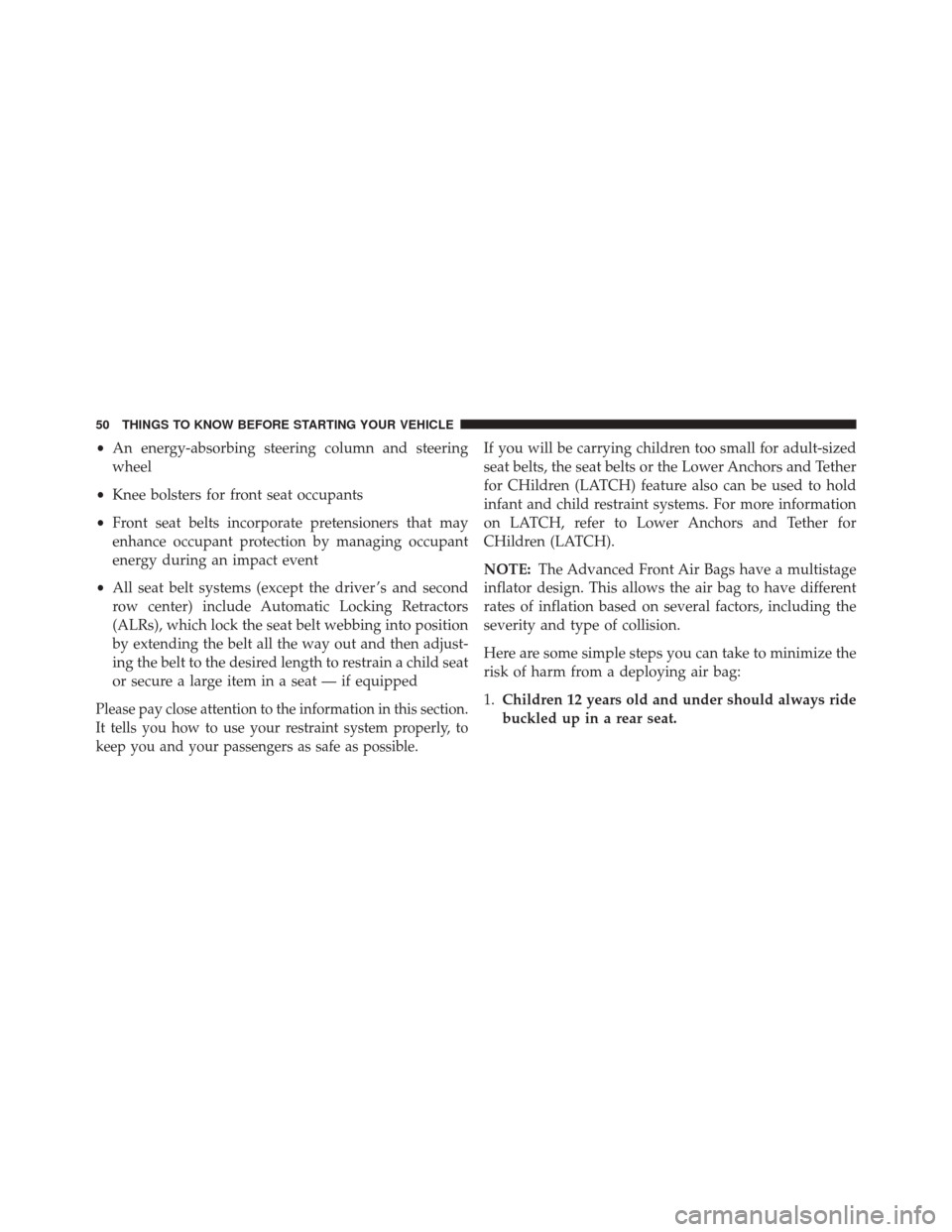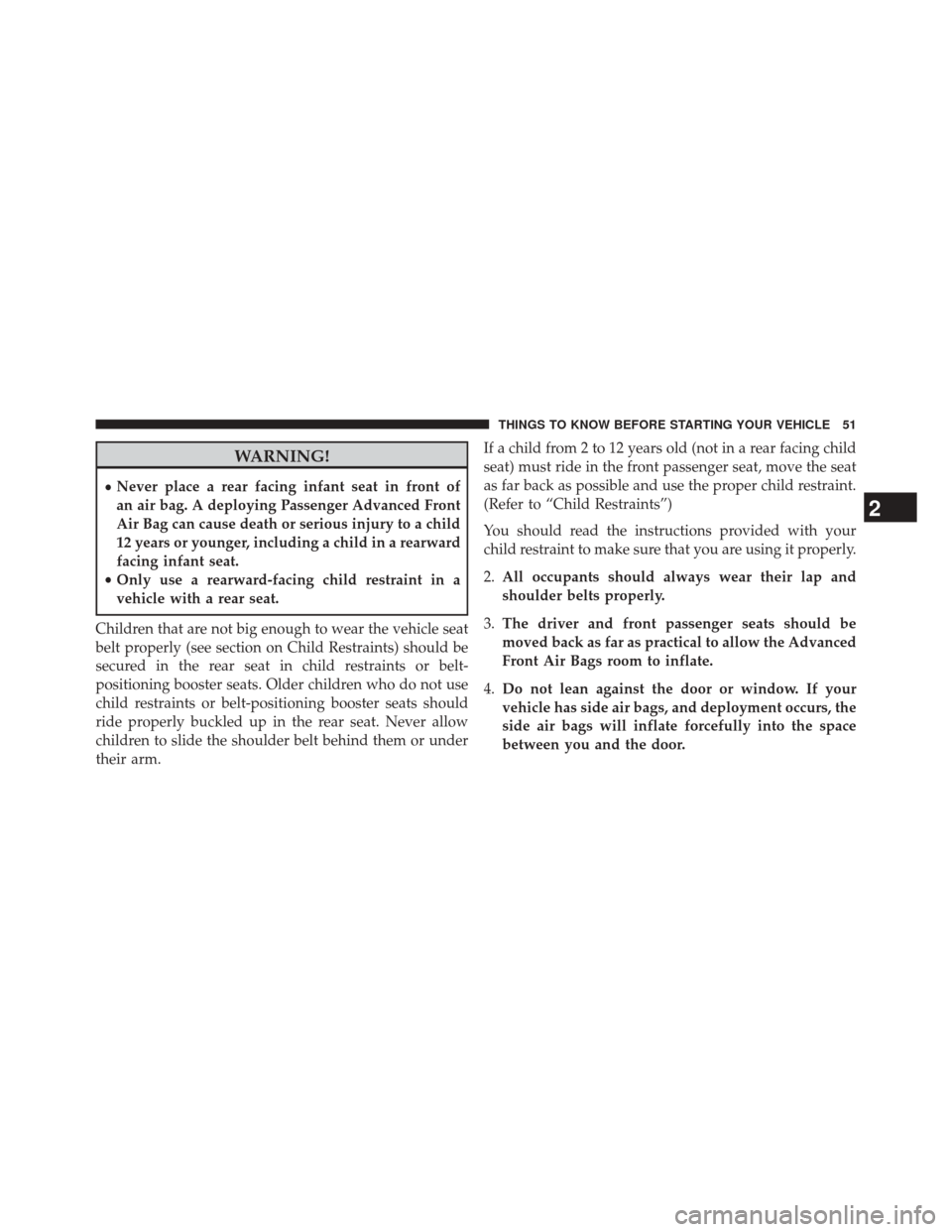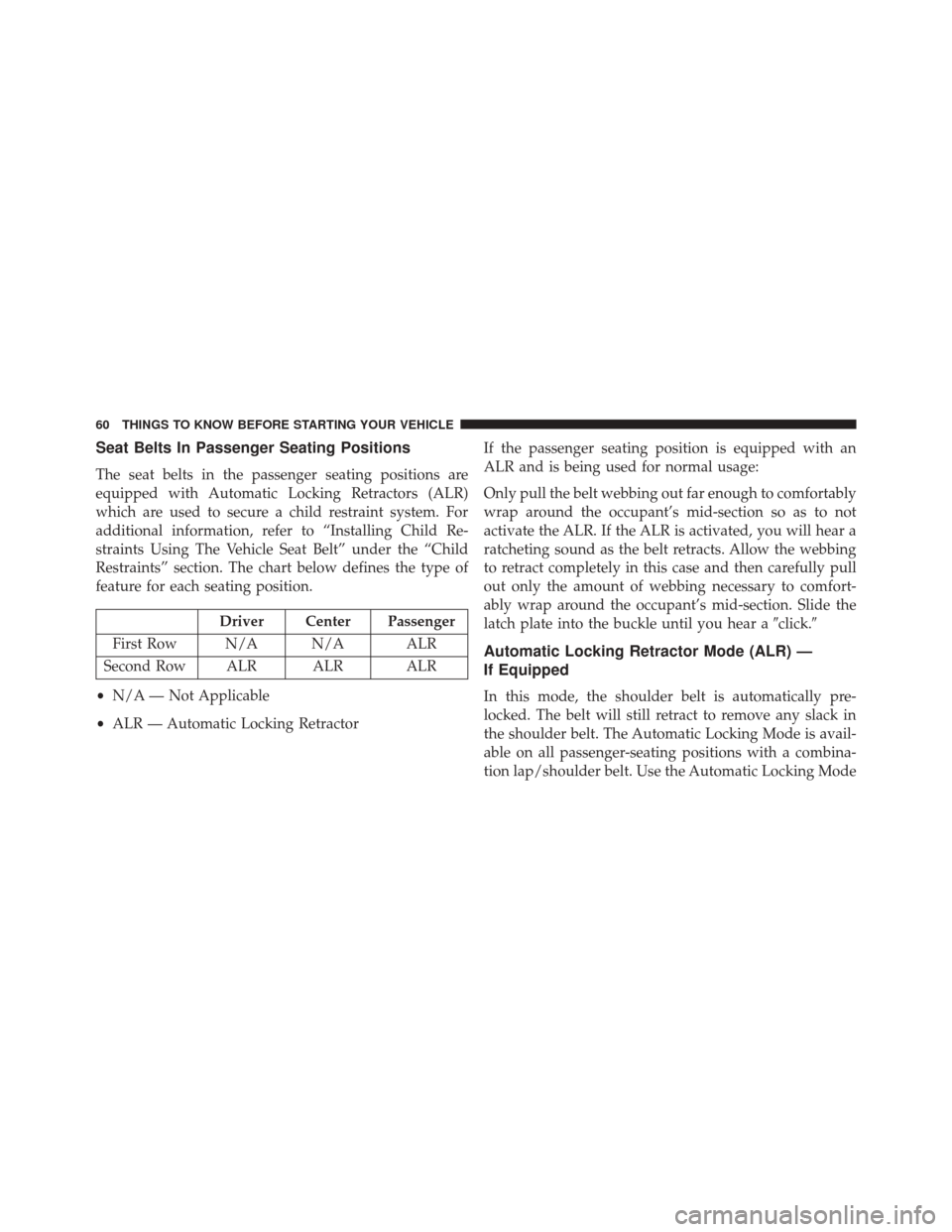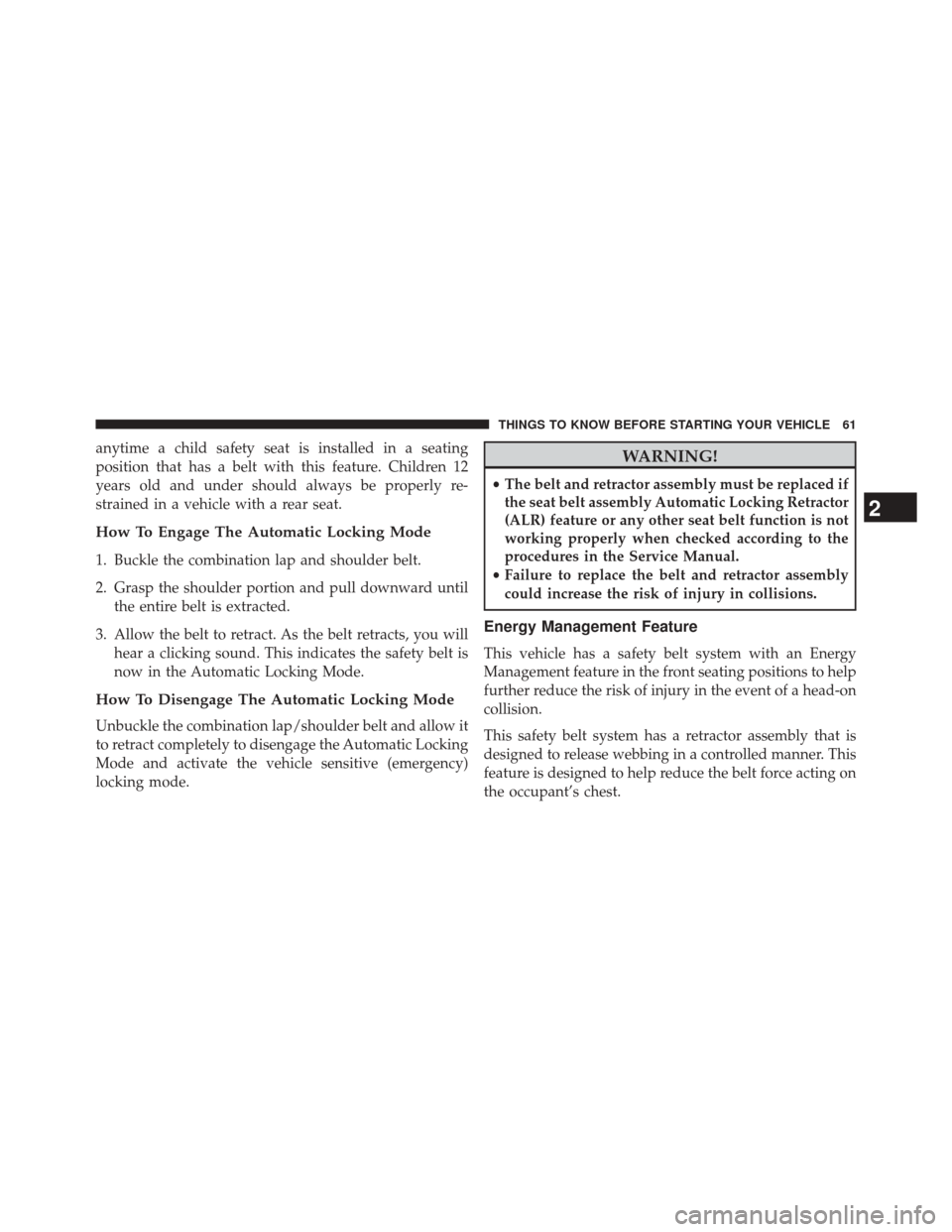Page 14 of 615

▫General Information ....................27
�
REMOTE STARTING SYSTEM — IF EQUIPPED . .28
▫ How To Use Remote Start ................28
� DOOR LOCKS .........................32
▫ Power Door Locks .....................33
▫ Child-Protection Door Lock System —
Rear Doors ..........................34
� KEYLESS ENTER-N-GO™ .................36
� WINDOWS ...........................41
▫ Power Windows .......................41
▫ Wind Buffeting .......................45
� LIFTGATE ............................45
▫ Power Liftgate — If Equipped .............46�
OCCUPANT RESTRAINTS ................49
▫ Lap/Shoulder Belts ....................53
▫ Lap/Shoulder Belt Operating Instructions .....54
▫ Lap/Shoulder Belt Untwisting Procedure .....58
▫ Adjustable Upper Shoulder Belt Anchorage . . .59
▫ Seat Belts In Passenger Seating Positions ......60
▫ Automatic Locking Retractor Mode (ALR) —
If Equipped ..........................60
▫ Energy Management Feature ..............61
▫ Seat Belt Pretensioners ..................62
▫ Supplemental Active Head Restraints (AHR) . . .62
▫ Enhanced Seat Belt Use Reminder System
(BeltAlert®) ..........................66
12 THINGS TO KNOW BEFORE STARTING YOUR VEHICLE
Page 15 of 615
▫Seat Belt Lock Out ......................67
▫ Seat Belts And Pregnant Women ...........67
▫ Seat Belt Extender .....................68
▫ Supplemental Restraint System (SRS) —
Air Bags ............................68
▫ Advanced Front Air Bag Features ...........71
▫ Air Bag Deployment Sensors And Controls ....76
▫ Event Data Recorder (EDR) ...............84
▫ Child Restraints .......................85 �
ENGINE BREAK-IN RECOMMENDATIONS . . .111
� SAFETY TIPS .........................112
▫ Transporting Passengers .................112
▫ Exhaust Gas .........................112
▫ Safety Checks You Should Make Inside The
Vehicle .............................113
▫ Periodic Safety Checks You Should Make
Outside The Vehicle ...................116
2
THINGS TO KNOW BEFORE STARTING YOUR VEHICLE 13
Page 36 of 615
If you press the door lock switch while the Key Fob is in
the vehicle and the driver’s door is open, the doors will
not lock.
If a rear door is locked, it cannot be opened from inside
the vehicle without first unlocking the door. The door
may be unlocked manually by raising the lock knob.
Child-Protection Door Lock System — Rear Doors
To provide a safer environment for small children riding
in the rear seats, the rear doors are equipped with
Child-Protection Door Lock system.
To Engage Or Disengage The Child-Protection
Door Lock System
1. Open the rear door.
2. Insert the tip of the emergency key into the lock androtate to the LOCK or UNLOCK position.
3.
Repeat steps 1 and 2 for the opposite rear door.
Child-Protection Door Lock Location
34 THINGS TO KNOW BEFORE STARTING YOUR VEHICLE
Page 37 of 615
WARNING!
Avoid trapping anyone in a vehicle in a collision.
Remember that the rear doors can only be opened
from the outside when the Child-Protection locks are
engaged (locked).
NOTE: For emergency exit from the rear seats when the
Child-Protection Door Lock System is engaged, manually
raise the door lock knob to the unlocked position, roll
down the window, and open the door using the outside
door handle.
Child-Protection Door Lock Function
2
THINGS TO KNOW BEFORE STARTING YOUR VEHICLE 35
Page 52 of 615

•An energy-absorbing steering column and steering
wheel
• Knee bolsters for front seat occupants
• Front seat belts incorporate pretensioners that may
enhance occupant protection by managing occupant
energy during an impact event
• All seat belt systems (except the driver ’s and second
row center) include Automatic Locking Retractors
(ALRs), which lock the seat belt webbing into position
by extending the belt all the way out and then adjust-
ing the belt to the desired length to restrain a child seat
or secure a large item in a seat — if equipped
Please pay close attention to the information in this section.
It tells you how to use your restraint system properly, to
keep you and your passengers as safe as possible.
If you will be carrying children too small for adult-sized
seat belts, the seat belts or the Lower Anchors and Tether
for CHildren (LATCH) feature also can be used to hold
infant and child restraint systems. For more information
on LATCH, refer to Lower Anchors and Tether for
CHildren (LATCH).
NOTE: The Advanced Front Air Bags have a multistage
inflator design. This allows the air bag to have different
rates of inflation based on several factors, including the
severity and type of collision.
Here are some simple steps you can take to minimize the
risk of harm from a deploying air bag:
1. Children 12 years old and under should always ride
buckled up in a rear seat.
50 THINGS TO KNOW BEFORE STARTING YOUR VEHICLE
Page 53 of 615

WARNING!
•Never place a rear facing infant seat in front of
an air bag. A deploying Passenger Advanced Front
Air Bag can cause death or serious injury to a child
12 years or younger, including a child in a rearward
facing infant seat.
• Only use a rearward-facing child restraint in a
vehicle with a rear seat.
Children that are not big enough to wear the vehicle seat
belt properly (see section on Child Restraints) should be
secured in the rear seat in child restraints or belt-
positioning booster seats. Older children who do not use
child restraints or belt-positioning booster seats should
ride properly buckled up in the rear seat. Never allow
children to slide the shoulder belt behind them or under
their arm. If a child from 2 to 12 years old (not in a rear facing child
seat) must ride in the front passenger seat, move the seat
as far back as possible and use the proper child restraint.
(Refer to “Child Restraints”)
You should read the instructions provided with your
child restraint to make sure that you are using it properly.
2.
All occupants should always wear their lap and
shoulder belts properly.
3. The driver and front passenger seats should be
moved back as far as practical to allow the Advanced
Front Air Bags room to inflate.
4. Do not lean against the door or window. If your
vehicle has side air bags, and deployment occurs, the
side air bags will inflate forcefully into the space
between you and the door.
2
THINGS TO KNOW BEFORE STARTING YOUR VEHICLE 51
Page 62 of 615

Seat Belts In Passenger Seating Positions
The seat belts in the passenger seating positions are
equipped with Automatic Locking Retractors (ALR)
which are used to secure a child restraint system. For
additional information, refer to “Installing Child Re-
straints Using The Vehicle Seat Belt” under the “Child
Restraints” section. The chart below defines the type of
feature for each seating position.
Driver Center Passenger
First Row N/A N/A ALR
Second Row ALR ALR ALR
• N/A — Not Applicable
• ALR — Automatic Locking Retractor If the passenger seating position is equipped with an
ALR and is being used for normal usage:
Only pull the belt webbing out far enough to comfortably
wrap around the occupant’s mid-section so as to not
activate the ALR. If the ALR is activated, you will hear a
ratcheting sound as the belt retracts. Allow the webbing
to retract completely in this case and then carefully pull
out only the amount of webbing necessary to comfort-
ably wrap around the occupant’s mid-section. Slide the
latch plate into the buckle until you hear a
�click.�
Automatic Locking Retractor Mode (ALR) —
If Equipped
In this mode, the shoulder belt is automatically pre-
locked. The belt will still retract to remove any slack in
the shoulder belt. The Automatic Locking Mode is avail-
able on all passenger-seating positions with a combina-
tion lap/shoulder belt. Use the Automatic Locking Mode
60 THINGS TO KNOW BEFORE STARTING YOUR VEHICLE
Page 63 of 615

anytime a child safety seat is installed in a seating
position that has a belt with this feature. Children 12
years old and under should always be properly re-
strained in a vehicle with a rear seat.
How To Engage The Automatic Locking Mode
1. Buckle the combination lap and shoulder belt.
2. Grasp the shoulder portion and pull downward untilthe entire belt is extracted.
3. Allow the belt to retract. As the belt retracts, you will hear a clicking sound. This indicates the safety belt is
now in the Automatic Locking Mode.
How To Disengage The Automatic Locking Mode
Unbuckle the combination lap/shoulder belt and allow it
to retract completely to disengage the Automatic Locking
Mode and activate the vehicle sensitive (emergency)
locking mode.
WARNING!
•The belt and retractor assembly must be replaced if
the seat belt assembly Automatic Locking Retractor
(ALR) feature or any other seat belt function is not
working properly when checked according to the
procedures in the Service Manual.
• Failure to replace the belt and retractor assembly
could increase the risk of injury in collisions.
Energy Management Feature
This vehicle has a safety belt system with an Energy
Management feature in the front seating positions to help
further reduce the risk of injury in the event of a head-on
collision.
This safety belt system has a retractor assembly that is
designed to release webbing in a controlled manner. This
feature is designed to help reduce the belt force acting on
the occupant’s chest.
2
THINGS TO KNOW BEFORE STARTING YOUR VEHICLE 61